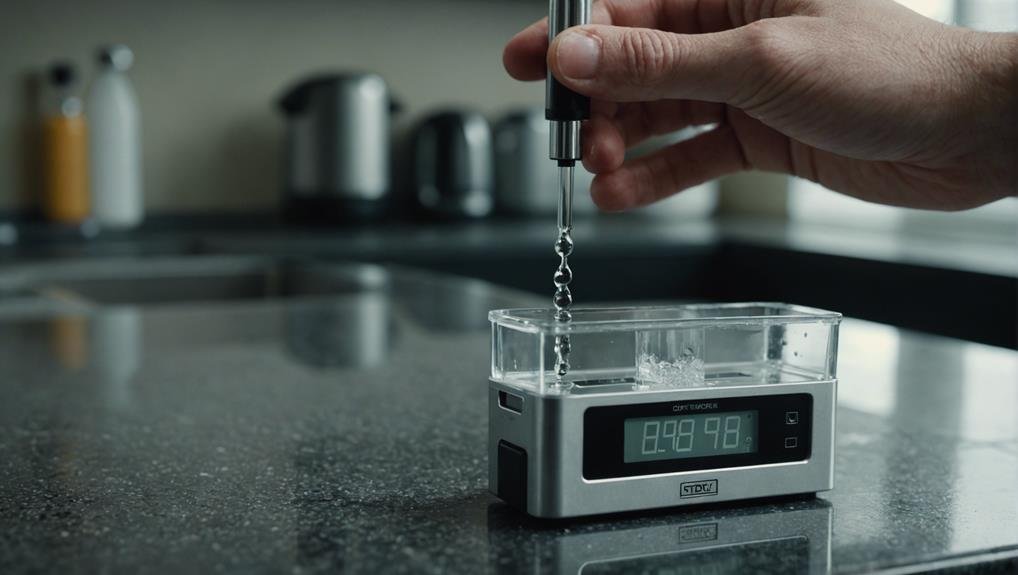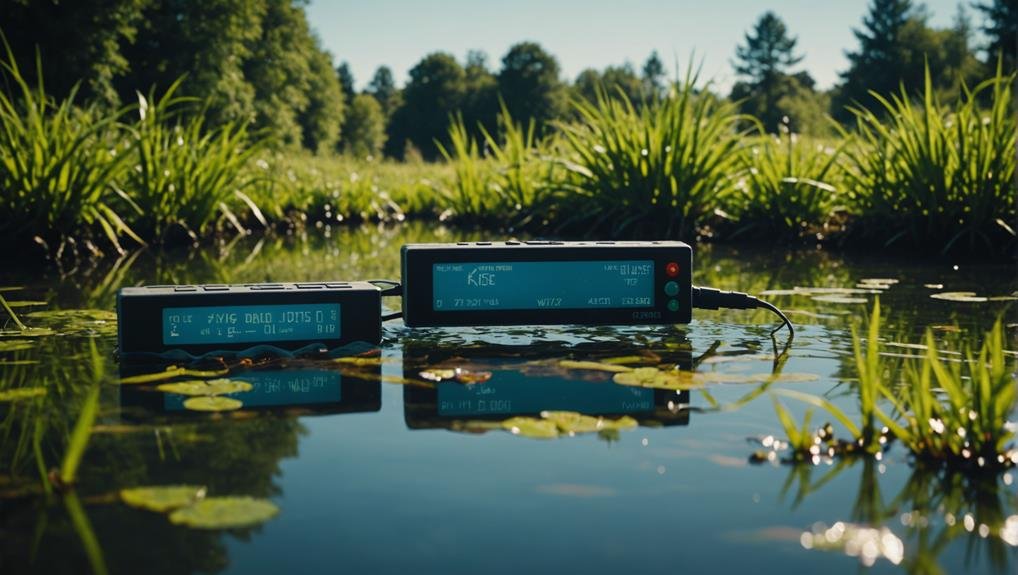We rely on digital tools like TDS meters, pH meters, and ORP meters to accurately evaluate water quality by measuring TDS, pH levels, and ORP.
Some of the links in this article may be affiliate links. If you make a purchase through these links, we may earn a small commission at no extra cost to you. Thank you.
It is crucial to regularly calibrate these devices using buffer solutions to ensure precise readings. Additionally, maintaining these devices by cleaning sensors is essential to prolong their lifespan and reliability.
Comparing water samples from various sources, such as tap and filtered water, enables us to assess the effectiveness of our treatment systems.
Soft water is beneficial for appliances as it reduces mineral buildup, enhancing their efficiency. Understanding these fundamental concepts empowers us to confidently monitor the quality and safety of our water.
Delving deeper into enhancing water quality monitoring techniques can provide further insights.
Understanding Water Hardness
Understanding water hardness is crucial for selecting the most suitable water source for our needs. Water hardness indicates the amount of dissolved minerals, mainly calcium and magnesium, present in our water. We use a TDS meter, which measures Total Dissolved Solids, to determine the mineral content and assess water quality accurately.
In regions like Tucson, Arizona, tap water often has high hardness levels, reaching up to 397 on the TDS scale. This excessive hardness can lead to issues in various applications, such as household appliances and coffee machines, due to scale buildup and maintenance challenges.
By comparing different water sources like tap water, refrigerator-filtered water, and purified water, we can identify the best option for our requirements.
For example, water treatment systems designed to reduce hardness can significantly lower TDS levels, sometimes as low as 13. This softer water is beneficial for preventing scale-related problems.
Regularly testing our water quality parameters empowers us to make informed choices and ensure the efficiency and durability of our appliances and systems are maintained.
Types of Digital Water Testers
Digital water testers like TDS meters, pH meters, and ORP meters are crucial for accurately measuring water quality parameters. These devices provide precise readings for TDS, pH levels, and ORP, ensuring the safety and quality of water used in pools, aquariums, drinking water systems, and industrial processes.
TDS meters measure dissolved solids in water, helping assess water hardness and purity. pH meters determine water acidity or alkalinity, essential for maintaining optimal conditions in aquariums, pools, and drinking water. ORP meters evaluate oxidation-reduction potential, indicating water's ability to break down contaminants and maintain disinfection levels.
These testers are user-friendly, with simple operation, suitable for professionals and homeowners alike. They offer a quick and convenient solution for water quality testing, ensuring equipment safety, quality control, and proper maintenance across various applications.
Using a TDS Meter

Let's dive into how to effectively utilize a TDS meter to assess water quality. This handy device measures total dissolved solids in water, providing a quick and precise indication of its purity.
To test your water, simply switch on the meter and immerse the probe into a water sample. The meter will then show a reading in parts per million (ppm), indicating the amount of dissolved solids present.
For drinking water, the ideal TDS levels typically fall between 50 to 500 ppm. Within this range, water is considered safe to drink and should taste clean. Elevated TDS levels can impact water taste, clarity, and even the longevity of water-utilizing appliances like coffee makers and dishwashers.
Regular use of a TDS meter enables us to track fluctuations in water quality over time. This becomes especially crucial for those relying on well water or residing in areas with varying water conditions.
Regular testing empowers us to promptly identify and rectify any emerging issues, ensuring the continuous quality of our drinking water. By consistently employing a TDS meter, we stay informed about water quality and ensure it remains within safe parameters.
Measuring Ph Levels
Measuring pH levels in water is crucial for determining its acidity or alkalinity to ensure it meets safety and quality standards. The use of digital pH meters allows for quick and accurate water testing, providing readings on a scale of 0-14 where pH 7 is considered neutral. A pH reading below 7 indicates acidity, while a reading above 7 indicates alkalinity.
Digital pH meters have become widely used across various industries such as food, pharmaceuticals, agriculture, and environmental monitoring due to their precise measurements. These devices offer features like quick results, portability for easy use in different locations, and convenience in operation, making them ideal for field testing.
Using a digital pH meter is simple: just immerse the probe into the water sample and wait for the reading to stabilize. The device will then display the pH level, enabling informed decision-making based on the data obtained.
Proper calibration is essential to ensure accuracy, which will be discussed in the next section. Understanding pH levels and their significance in water testing is key to upholding high standards in different fields.
Calibrating Digital Devices

Ensuring the accuracy of our pH measurements is crucial for reliable water testing. Regular calibration of our digital devices with standardized buffer solutions is essential to maintain precision and reliability. By aligning our tools with known standards, we guarantee the accuracy and trustworthiness of our readings.
Buffer solutions play a key role in calibration by providing reference points for precise measurements. These solutions have well-defined pH values, enabling our devices to make necessary adjustments. Consistent calibration not only reduces errors but also ensures consistent and dependable results for water quality analysis.
When calibrating our digital devices, it's important to select buffer solutions with pH values close to the expected range of our water samples. Following the manufacturer's instructions for calibration procedures is essential to achieve accurate results. Before and after calibration, rinsing the electrode with distilled water is necessary to prevent contamination. Keeping a detailed log of calibration dates and results helps us monitor the performance of our devices over time.
Comparing Water Sources
When evaluating water sources, it's crucial to consider factors like water hardness levels and their impact on appliances such as coffee machines. The quality of water is closely tied to its hardness, which directly affects the performance and maintenance needs of our coffee makers.
For instance, in Tucson, Arizona, tap water registers a hardness level of 397, while refrigerator water measures at 338. These high levels of hardness can result in scale buildup in coffee machines, ultimately affecting their efficiency and lifespan.
In contrast, Costco purified water offers a significantly lower hardness level of 27, providing a softer alternative. Additionally, water from a five-gallon machine boasts a hardness level of only 13, making it an excellent choice for those seeking to minimize the effects of hard water on their appliances.
Utilizing a TDS (Total Dissolved Solids) meter can aid in effectively comparing these water sources. By measuring TDS levels, we can determine the most suitable water option for our specific needs, ensuring that our coffee machines operate smoothly and effectively.
Understanding and comparing water hardness allows us to make informed decisions regarding water quality.
Benefits of Soft Water

With the disadvantages of hard water in mind, the advantages of soft water become evident. Soft water, by reducing mineral content, addresses many issues related to hard water, improving our daily routines in various ways.
One significant benefit of soft water is the reduction of limescale buildup in appliances and pipes. This results in longer-lasting water-using devices and lower maintenance expenses.
Additionally, soft water enhances the performance of soaps and detergents, leading to better cleaning outcomes with improved lathering, especially beneficial in homes and businesses.
Studies have shown that soft water is gentler on skin and hair, preventing dryness and irritation, and promoting healthier skin and glossier hair.
Moreover, using soft water can contribute to energy savings, as appliances such as water heaters operate more efficiently without mineral deposits hindering their function.
Maintaining Testing Equipment
Maintaining our water testing equipment's accuracy and durability relies on consistent upkeep. Regular calibration checks are vital to ensure precise measurements and long-term reliability. Adhering to the manufacturer's recommended calibration intervals is crucial to keep our equipment functioning optimally.
Proper storage is equally essential. Storing the devices in a dry, cool environment when not in use can significantly extend their lifespan. It's also important to clean the electrode before and after each use to prevent contamination, maintaining the accuracy and consistency of our readings.
Replacing batteries when necessary is another important maintenance task. Monitoring battery levels and replacing them promptly is key to ensuring uninterrupted testing. Following the manufacturer's maintenance instructions is imperative to ensure the equipment's peak performance. Each piece of equipment may have specific maintenance requirements that, if overlooked, could impact its longevity and accuracy.
Improving Water Quality

Improving water quality can be achieved by utilizing digital devices to identify and address contaminants efficiently. These tools, like TDS meters, help measure water hardness and detect dissolved solids present in water. For instance, Tucson tap water with a measurement of 397 ppm indicates high hardness, while Costco purified water measures only 27 ppm.
Digital devices play a crucial role in understanding water conditions, aiding in assessing the effectiveness of filtration methods like refrigerator filters. It's common for these filters to have little impact on water quality, as seen through minimal differences in TDS meter readings between tap and filtered water. This data can guide individuals towards adopting more effective water treatment solutions, such as specialized water machines.
To enhance water quality, it's important to take the following actions:
- Regular testing: Utilize digital meters regularly to monitor changes in water quality.
- Selection of efficient filters: Choose high-quality water filtration systems based on readings from digital devices.
- Appliance maintenance: Use water with lower hardness levels to prevent calcium buildup in appliances like coffee machines.
- Regular descaling: Ensure appliances function efficiently and have a longer lifespan by descaling them regularly.
Conclusion
As we delve into understanding water quality, digital testers act as our reliable guide. Just like a hiker relies on a compass to navigate dense forests, we rely on these devices to lead us through water testing.
With tools like TDS meters and pH testers, we ensure our water is safe and soft.
By regularly maintaining our equipment and conducting tests, we aren't just improving water quality; we're also enhancing our overall well-being.

